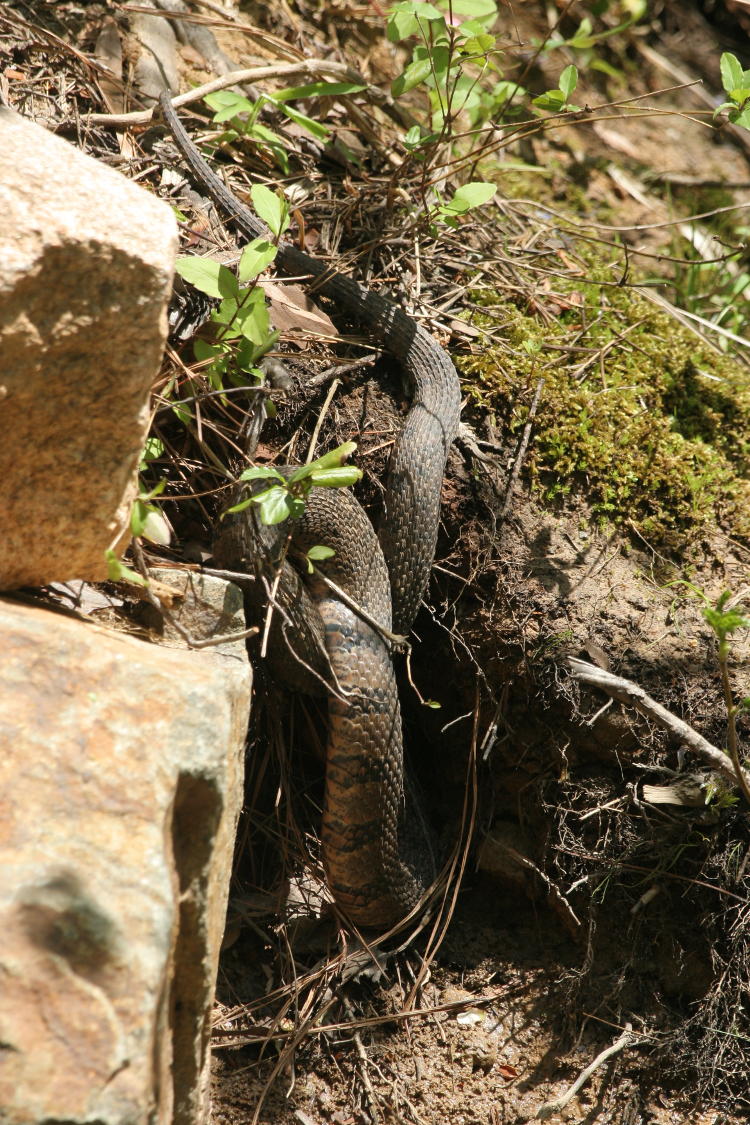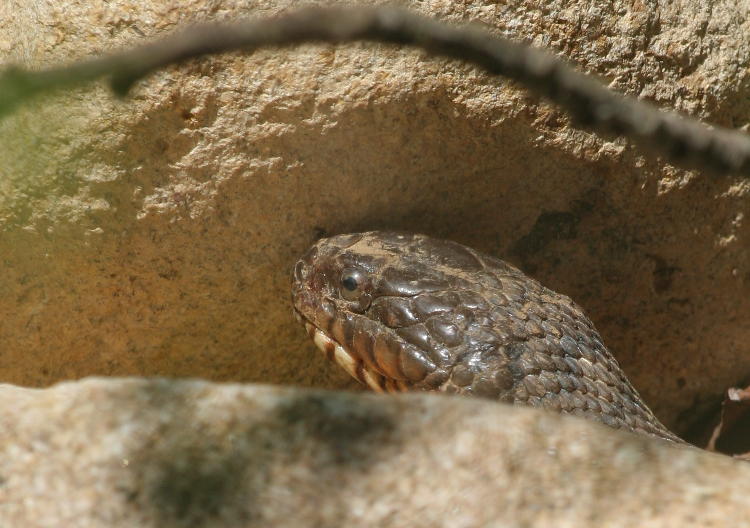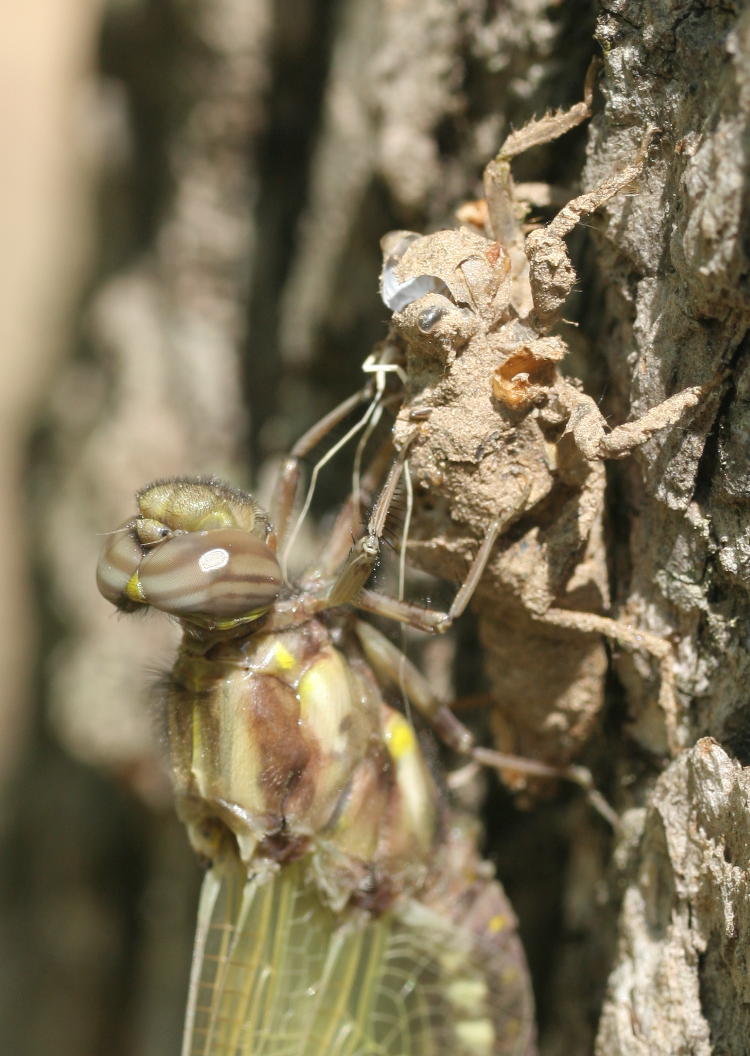I’ve made two mentions of it now, but on a particular day last week I really and truly got out and did a little shooting – not anywhere near enough to make up for the poor showing in the first quarter of the year, but more than, say, nothing. And then the following morning I got some more, with both days contributing to the recent slideshow, but for this post we’re only talking about the first.
Unfortunately, a lot of the images didn’t pass muster, for a variety of reasons – poor light and shooting macro photos handheld among them – so we’re just going to review two of the other subjects from the outing. We’re still waiting for the boom that warm weather brings; I think most species have had their faith in spring completely ruined now and are hedging their bets, so subjects are still a bit sparse. A five-lined skink played tag with me around a tree, but one of the pond sliders bravely maintained its basking spot as I ambled much closer than I normally could – that’s the image in this preliminary post. I was kind of expecting to see it blind in the eye facing me, since that was the only way I’d gotten this close to one last year, but I could see it blinking in that eye at least, so I can’t offer a better explanation.
Near an inlet to the pond, however, I spotted a suspicious-looking tree root – suspicious in that I didn’t think a tree root had been there before. Attaching the longer lens confirmed my suspicions; it wasn’t a root, but a northern water snake (Nerodia sipedon sipedon,) delving industriously among the rocks and rootlets to make a burrow for itself.

I’ve seen one in the same location a couple of times before, and it’s likely this was the same individual – it was certainly sizable enough, roughly a meter long but up to 7cm in girth. We’d had an absolute deluge a few days previous to this, and it’s possible that the inflow right past these rocks clogged its former burrow with mud and debris, which it was trying to excavate. Eventually, it brought its head out of the shadows, but not in the most photogenic manner.

Due to the light and the path the snake appeared to be wending, I realized I’d probably do better coming from a different angle, which required getting to the opposite side of the inlet channel, a detour of a few dozen meters. On the way, I spotted another potential subject, but knew it wasn’t going anyplace soon while the snake might disappear, so I stuck with my first subject. Unfortunately, the opposite side of the channel wasn’t as good a shooting angle as I’d believed, with too much underbrush in the way, and I was left trying to maneuver for a clear shot while not alerting the snake to my now much-more-visible position. I succeeded, but for one frame only, and this is a tight crop from the original.

Almost immediately after this, I shifted position for a slightly better view and caught the attention of the snake, which launched itself towards me with obvious malicious intent shot into the water and disappeared, as they are much more inclined to do – you pretty much have to corner or grab them to get any kind of defensive response, and even then it might be half-hearted. I knew from experience that the snake would re-surface within about two minutes, being far less capable of going without air than turtles or frogs are, but it would also peek out among concealing cover, and wouldn’t venture from the water for several minutes more, so I let it be and went back to the other subject I’d found.
On the trunk of a tree a few meters from the water’s edge, a newly-emerged adult dragonfly was still pumping up and drying out its wings before being able to fly, perched on its just-molted exoskeleton. I liked the juxtaposition, but was working without the macro flash rig, so getting focus and depth together was a challenge, and most of the shots that I attempted were crapola, but I yet managed what I was after.

Now, the caterpillar to butterfly metamorphosis is pretty damn dramatic, when you compare anatomy, but it takes place over a period of weeks within a protective cocoon. The difference between the aquatic nymph and flying adult stages of dragonflies and damselflies is pretty significant too, and it becomes apparent in a period of minutes. Yes, it had emerged from that brown husk not half an hour before, seemingly at least three times larger already, but it’s the head that I get the biggest kick out of. The old exoskeleton is split apart along the edges of the eyes and down the middle back of the head, outlined by the white interior surface, but just look at how dramatically larger both the eyes and the ‘face’ are. And I can’t tell you where all this extra mass comes from, because the insect isn’t even drinking water for this to occur, and is in fact drying out slightly; at best, it might be expanding its interior organs with air, but the respiratory rate for insects is remarkably slow. I don’t doubt that the molted skin is drying out and shrinking slightly itself, but I’ve seen this occur with other species and the amount of shrinkage isn’t significant, or even noticeable.
As yet, I still have the full molting sequence, start to finish, on my list of photography goals, since I still haven’t come across one right before it begins to emerge, though I’ve had a few close misses. Let’s put that goal down specifically for this summer; that seems reasonable. What it’s likely to require is getting out early in the morning when I have plenty of time and watching the water edges carefully, then staking out any nymph that appears until the process is complete. We’ll have to see how that goes.




















































